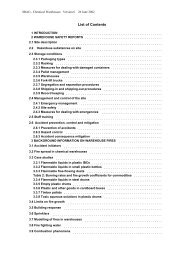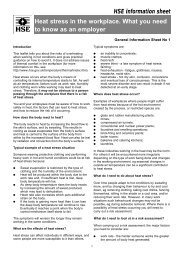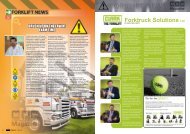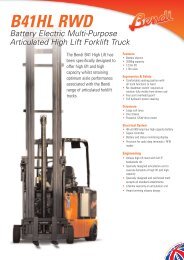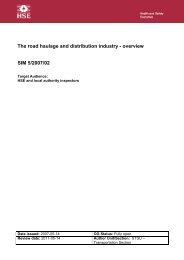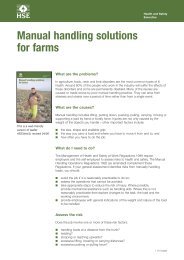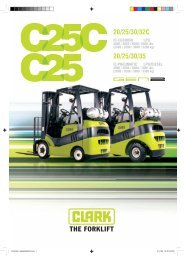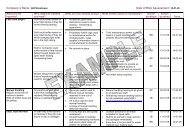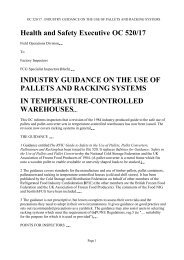Workplace transport inspection pack
Workplace transport inspection pack
Workplace transport inspection pack
Create successful ePaper yourself
Turn your PDF publications into a flip-book with our unique Google optimized e-Paper software.
For some work at height on a vehicle there may not be a single, simple solution, buta range of options will have to be considered as part of the process of planning theloading/unloading activity or maintenance operation. Using the hierarchy as thebasis, the best solution or combination of solutions in the specific circumstances canbe applied. Selection of the most appropriate vehicle for the task or specification ofessential access equipment may reduce the need for working at height and reducethe risk of falls.The Work at Height Regulations are looking for the application of the hierarchy toprovide reasonably practicable solutions to manage the risk of work at height on avehicle. (NEE template INs 9 & 10.)Some practical examples of solutions within the hierarchy of controls:• Avoid working at height unless it is essential - positioning of plant controlsfor equipment such as lorry loader cranes, refrigeration units (see casestudies 3 and 4) and tanker controls at ground level to avoid the need to climbup; the use of ground based sheeting systems instead of manually sheeting.Use of palletised loads that can be unloaded by lift truck, and loading facilities,e.g. loading bays. In many cases installing such systems not only reducesrisks, it increases efficiency and in the long term saves money.• Prevent falls by using work equipment(a) that protects all those at risk – Working with delivery vehicle andequipment suppliers to determine the optimum design and means of access.Platforms with handrails and access steps - vehicle based controls are betterthan site based controls as they travel with the vehicle and are reliablyavailable (guardrailed platforms for accessed areas on vehicles eg tankertops). Site based platforms may prevent falls or mitigate against the effect ofa fall depending on their height. (eg Case study 10 William Hare)Assessment of loading and delivery locations to determine where site-basedcontrols exist or where vehicle-based controls will be needed.There may be problems guaranteeing such off-vehicle equipment will alwaysbe available when access is needed, especially as vehicles usually visit sitescontrolled by other duty holders on a one off basis.(b) that protects the individual – work restraint systems ie a harness andlanyard that make it impossible for a person to get to a fall position.• Mitigate falls by using work equipment to minimise the distance andconsequences of a fall(a) that protects all those at risk – soft landing systems, nets(b) that protects the individual – a personal fall arrest system with theanchorage point sited above the head. Any PPE solution relies heavily ongood training, instruction and supervision. A company who distribute concreteproducts trialled a vehicle based PPE system, but found it interfered with theoperation of the lorry mounted crane and so did not take the solution forwardin the long term.• Mitigate falls through training, instruction or other means eg ensureaccess equipment is inspected regularly, apply sensible housekeeping



